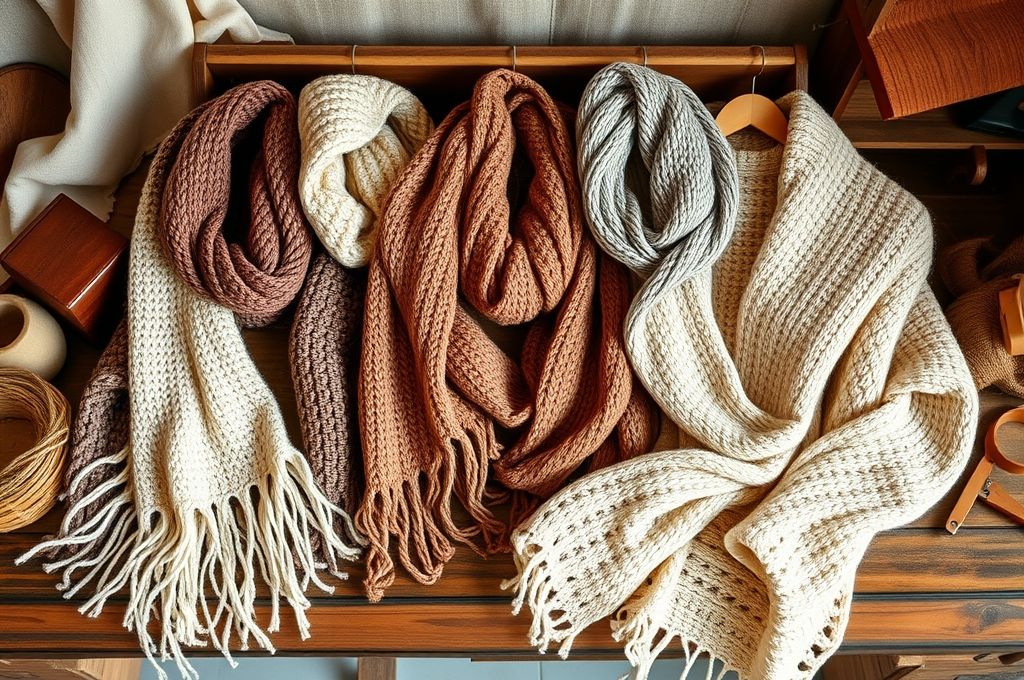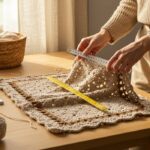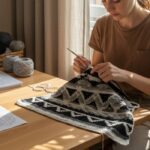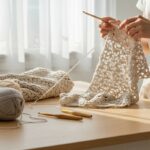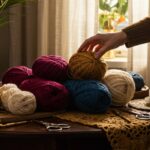Have you ever wrapped yourself in a cozy, handmade scarf and instantly felt a little more confident, a little more you? There’s something magical about wearing a piece of clothing that was lovingly crafted stitch by stitch—especially when it’s something as timeless and versatile as a crocheted wearable. From delicate lace shawls to chunky winter sweaters, crochet wearables are more than just fashion statements; they’re expressions of creativity, comfort, and personal style. And today, they’re having a major moment.
Crochet has evolved from a nostalgic craft associated with grandmothers to a vibrant, modern art form embraced by designers, influencers, and everyday makers around the world. Whether you’re a seasoned crocheter or someone who’s just picked up a hook for the first time, creating stylish wearables like scarves, shawls, and sweaters is not only deeply satisfying—it’s also a sustainable way to build a unique wardrobe. In this article, we’ll explore why crochet wearables are worth your time, dive into the beauty and function of each type, share practical tips for choosing patterns and materials, and inspire you to create (or wear!) something truly special. Get ready to fall in love with the art of handmade fashion all over again.
Why Crochet Wearables Are More Than Just Craft Projects
Crochet isn’t just a hobby—it’s a form of self-expression. When you make a wearable item like a scarf, shawl, or sweater, you’re not just following a pattern; you’re creating something with intention, texture, and soul. Unlike mass-produced clothing, handmade pieces carry a story. Each loop and stitch reflects your time, care, and creativity. And in a world where fast fashion dominates, choosing to make or wear crochet wearables is a quiet act of rebellion—a celebration of slow living and mindful consumption.
But beyond sentiment, crochet wearables offer real, tangible benefits. They’re customizable. Want a longer scarf? You can make it. Prefer a looser fit on your sweater? Adjust the pattern. Need a shawl in your favorite color? Pick the yarn yourself. This level of personalization is nearly impossible with store-bought clothes. Plus, handmade items often last longer because they’re made with attention to detail and higher-quality materials.
And let’s not forget the emotional rewards. Studies have shown that engaging in creative activities like crocheting can reduce stress, improve focus, and even boost mood. So when you wear something you made, you’re not just showing off your skills—you’re carrying a piece of your calm, your joy, and your resilience. That’s powerful.
As we dive into the world of crochet wearables, keep this in mind: these aren’t just accessories or garments. They’re wearable art, comfort tools, and confidence boosters—all rolled into one.
Scarves: The Perfect Entry Point for Crocheters
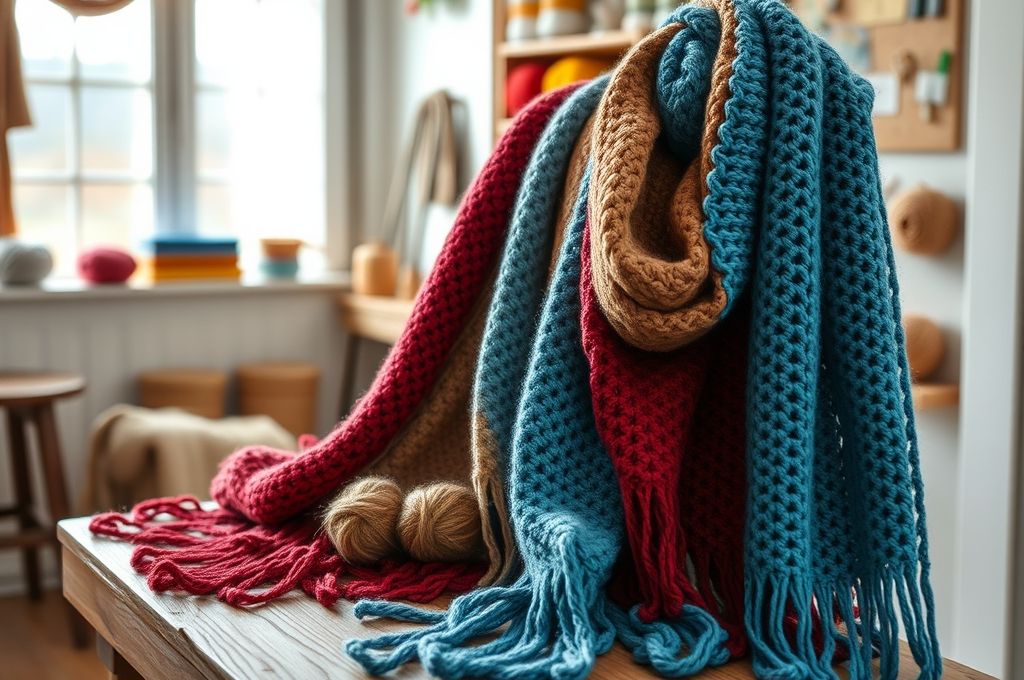
If you’re new to crochet, a scarf is the ideal first project. It’s simple, functional, and offers endless creative possibilities. Think of it as a blank canvas where you can experiment with stitches, colors, and textures without the pressure of shaping or sizing that comes with more complex garments.
Scarves are also incredibly practical. They provide warmth during colder months, add a pop of color to a neutral outfit, and can even be styled in multiple ways—draped loosely, wrapped tightly, or knotted for a chic look. Because they’re relatively quick to make, scarves give beginners a sense of accomplishment early on, which can be a huge motivator to keep going.
When choosing a scarf pattern, start with something basic, like a garter stitch or single crochet row. As you gain confidence, you can explore more intricate designs—shell stitches, ripple patterns, or even colorwork. The key is to pick a yarn that feels good to work with. For beginners, medium-weight (worsted) acrylic or wool-blend yarns are ideal because they’re durable, easy to handle, and come in a wide range of colors.
One of the best things about crocheting scarves is that they make thoughtful, heartfelt gifts. Imagine giving a loved one a handmade scarf in their favorite color—something they can wear all winter, reminded of your care with every use. And if you’re making for yourself? Choose bold hues or soft neutrals that match your wardrobe and personality.
Pro Tip: Add tassels, fringe, or pom-poms to give your scarf a fun, stylish finish. These small details can elevate a simple design and make it feel truly unique.
Shawls: Elegance, Comfort, and Versatility in One
While scarves are great for everyday wear, shawls bring a touch of elegance and versatility that’s hard to beat. Lightweight and often larger in size, shawls can be worn in countless ways—draped over the shoulders, wrapped around the body, or even used as a beach cover-up. They’re perfect for layering, transitioning between seasons, or adding drama to an outfit.
Crocheted shawls come in a variety of shapes: triangular, rectangular, circular, and crescent. Each shape offers different drape and styling options. For example, a triangular shawl naturally falls over the shoulders and down the back, making it ideal for formal events or chilly evenings. A crescent shawl, on the other hand, hugs the body more closely and is great for everyday wear.
One of the most popular types of crochet shawls is the lace shawl. Using openwork stitches like double crochet, chain spaces, and clusters, lace shawls are airy and delicate—perfect for spring and summer. Despite their light appearance, they provide just enough warmth and can be surprisingly durable when made with quality yarn.
But don’t think shawls are only for warm-weather wear. Chunky, textured shawls made with bulky yarns are perfect for winter. Imagine wrapping yourself in a cozy, oversized shawl while sipping tea by the fire—pure comfort.
Why shawls stand out:
- They require fewer precise measurements than sweaters.
- They allow for creative stitch patterns and color transitions.
- They’re portable projects—easy to carry in a bag and work on the go.
Whether you’re making a lacy heirloom piece or a bold, modern design, a crocheted shawl is a statement of style and craftsmanship.
Sweaters: The Ultimate Crochet Challenge (and Reward)
Now, let’s talk about the crown jewel of crochet wearables: the sweater. While scarves and shawls are fantastic starter projects, a crocheted sweater represents a major milestone for any maker. It’s more complex, requires planning, and involves shaping, sizing, and finishing—but the payoff is immense.
A handmade sweater is more than clothing; it’s a labor of love. It takes time, patience, and skill. But when you finish one, you’re rewarded with a garment that fits you perfectly—something you can’t always get off the rack. Plus, crocheted sweaters have a unique texture and drape that sets them apart from knitted or mass-produced versions.
There are many types of crochet sweaters to explore:
- Cardigans: Easy to wear and style, with buttons or ties.
- Pullover sweaters: Cozy and snug, great for layering.
- Duster cardigans: Long, open-front styles perfect for transitional weather.
- Crop tops and boleros: Lighter options for summer or layering.
The key to a successful sweater project is choosing the right pattern and yarn. Look for patterns with clear instructions, size charts, and photos. Many modern crochet designers offer detailed tutorials and video support, which can be a huge help.
Top Tips for Sweater Success:
- Always make a gauge swatch to ensure proper sizing.
- Use stitch markers to keep track of shaping.
- Break the project into sections (back, front, sleeves) to avoid feeling overwhelmed.
- Choose a yarn that’s soft, durable, and suitable for garments (avoid scratchy wools if you have sensitive skin).
And remember: it’s okay if your first sweater isn’t perfect. Every stitch teaches you something. The important thing is to enjoy the process and wear your creation with pride.
Choosing the Right Yarn: The Heart of Your Project
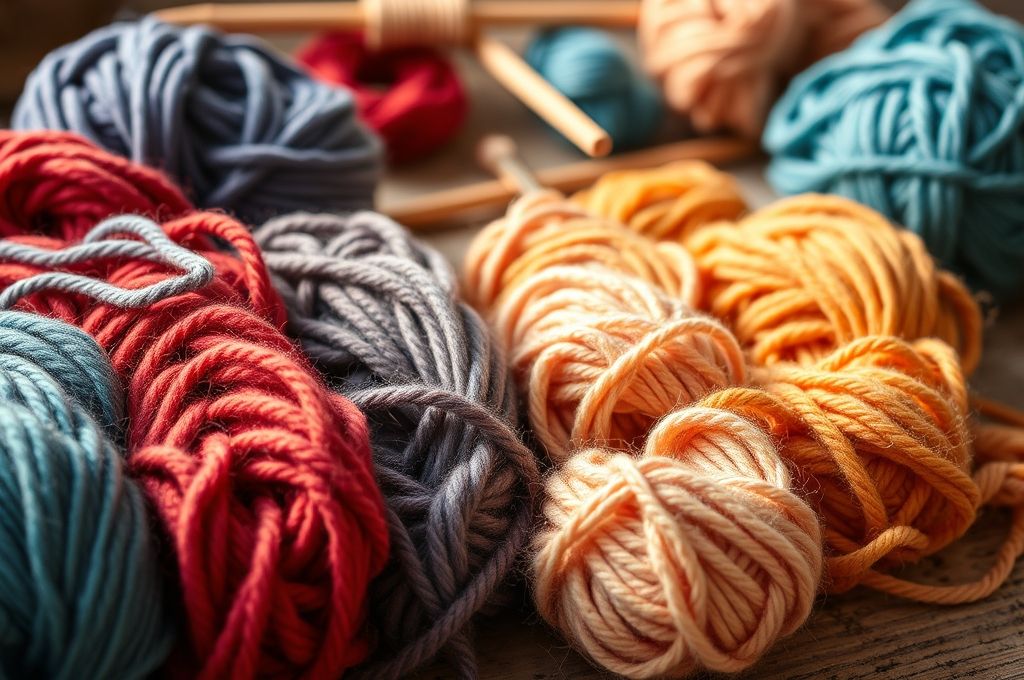
You can have the most beautiful pattern in the world, but if your yarn choice is off, the final result might not meet your expectations. Yarn is the foundation of every crochet project, and selecting the right one can make or break your wearable.
First, consider the fiber. Common options include:
- Acrylic: Affordable, easy to care for, and available in endless colors. Great for beginners.
- Cotton: Soft, breathable, and ideal for lightweight shawls or summer wearables.
- Wool: Warm, elastic, and excellent for winter garments. Some people find it itchy, so look for superwash or merino blends.
- Blends: Combine the best of different fibers—like wool-acrylic for warmth and softness, or cotton-polyester for durability.
Next, think about weight. Yarn comes in categories from lace (very fine) to jumbo (super bulky). For scarves and shawls, DK, worsted, or bulky weights are most common. Sweaters often use worsted or bulky yarns for structure and warmth.
Color and texture also matter. Solid colors highlight stitch patterns, while variegated or self-striping yarns add visual interest without changing threads. Textured yarns like bouclé or chenille can add depth but may be harder to work with for beginners.
Pro Tip: Always buy a little extra yarn. Running out mid-project—especially with dye-lot-sensitive yarns—can be frustrating. And don’t forget to check the care instructions. Will you machine wash it? Hand wash only? This affects how wearable and practical your finished piece will be.
When in doubt, visit a local yarn store or read online reviews. Seeing and feeling the yarn in person can help you make a better choice.
Patterns That Inspire: From Classic to Contemporary
The world of crochet patterns is vast and ever-evolving. Thanks to platforms like Ravelry, Etsy, and Instagram, you can find thousands of designs—from vintage-inspired lace to bold, modern geometrics. But with so many options, how do you choose?
Start by identifying your skill level. Beginner-friendly patterns usually use basic stitches (single, double, half-double crochet) and minimal shaping. Intermediate patterns might include color changes, lacework, or simple shaping. Advanced designs can involve intricate motifs, garment construction, or custom sizing.
Next, consider style and purpose. Are you making a cozy winter scarf? A beachy shawl? A statement sweater for a special occasion? Match the pattern to your needs and wardrobe.
Don’t be afraid to customize. Many patterns can be adapted—change the color, add sleeves to a vest, or adjust the length. Some designers even offer customization guides.
Trending Pattern Ideas in 2024:
- Granny stripe scarves: Classic granny squares turned into long, colorful scarves.
- Shell stitch shawls: Romantic, flowing designs with a vintage vibe.
- Oversized cardigans: Chunky, cozy, and perfect for layering.
- Color-blocked sweaters: Bold, modern looks using two or three contrasting colors.
And remember: a good pattern should include clear instructions, stitch counts, and photos. Look for ones with positive reviews and active designer support.
The Joy of Gifting Handmade Wearables
One of the most rewarding aspects of making crochet wearables is sharing them with others. There’s no gift more personal than something you made with your own hands. A crocheted scarf, shawl, or sweater says, “I thought of you. I spent time on this. I care.”
When gifting handmade items, consider the recipient’s style and needs. Do they love bold colors or prefer neutrals? Are they always cold or do they run warm? Tailor your project to their preferences.
Gift-Worthy Ideas:
- A soft, neutral shawl for a friend who loves yoga or meditation.
- A bright, cheerful scarf for a family member going through a tough time.
- A chunky sweater for a partner who hikes or spends time outdoors.
Pair your gift with a handwritten note explaining the time and love that went into it. You might even include care instructions or a small care kit (like a lint roller or wool soap).
And don’t underestimate the power of a handmade gift to start conversations. “Where did you get that?” often leads to, “I actually made it,” which opens the door to sharing your craft with others.
Sustainability and Mindful Fashion: The Bigger Picture
In an age of environmental concerns and fast fashion waste, crochet wearables offer a powerful alternative. The fashion industry is one of the largest polluters in the world, with millions of tons of clothing ending up in landfills each year. By choosing to make or wear handmade garments, you’re taking a stand for sustainability.
Crocheting supports slow fashion—the idea that clothing should be made with care, worn for years, and valued for its quality and story. When you make a sweater, you’re not contributing to mass production, unethical labor practices, or synthetic waste. Instead, you’re investing in durability, creativity, and individuality.
Even better: you can use eco-friendly materials. Look for organic cotton, recycled yarns, or locally sourced fibers. Some brands now offer yarns made from bamboo, hemp, or even recycled plastic bottles.
And if you ever finish a project and later grow tired of it? You can unravel it and reuse the yarn for something new—a concept nearly impossible with store-bought clothes.
By embracing crochet wearables, you’re not just making clothes. You’re making a statement about how you want to live—with intention, creativity, and respect for the planet.
Building Confidence Through Creation
It’s easy to doubt yourself when starting a new craft. “Can I really make a sweater?” “Will it look nice?” “What if I mess up?” These thoughts are normal. But here’s the truth: every expert crocheter was once a beginner who made their first wobbly scarf or misshapen shawl.
The beauty of crochet is that mistakes are part of the process. A dropped stitch, a miscounted row, or a slightly uneven edge doesn’t ruin the piece—it adds character. And each “mistake” teaches you something valuable.
As you complete projects, your confidence grows. You start to trust your hands, your eyes, and your instincts. You learn to read patterns, fix errors, and even design your own pieces. That confidence doesn’t stay in your craft room—it spills into other areas of life.
Wearing something you made sends a powerful message: I am capable. I am creative. I am enough. And when others notice and compliment your wearable, it reinforces that belief.
So don’t wait for perfection. Start where you are. Use what you have. Make something—even if it’s small. The journey of a thousand stitches begins with a single loop.
Final Thoughts: Wear Your Art, Share Your Story
Crochet wearables—scarves, shawls, and sweaters—are more than just functional items. They’re expressions of identity, tools for mindfulness, and acts of sustainability. Whether you’re crafting for yourself or others, each piece you make carries meaning.
From the rhythmic motion of the hook to the final stitch, crochet connects us—to our hands, our hearts, and our communities. It reminds us that beauty doesn’t have to be bought; it can be built, one stitch at a time.
So why not pick up your hook today? Try a new pattern, experiment with color, or finally start that sweater you’ve been dreaming about. Share your progress online, gift a piece to someone you love, or simply wrap yourself in the comfort of something handmade.
The world needs more handmade moments. And your next creation could be someone’s favorite wearable for years to come.
What will you make next? Share your favorite crochet wearable in the comments below—we’d love to hear your story!

Daniele Ferreira is passionate about the world of crochet, dedicating her time to exploring techniques, creating unique pieces, and sharing her knowledge with beginners and aficionados alike. With attention to detail and creativity, she transforms yarn into true works of art, inspiring others to discover the beauty and joy of this manual art.

